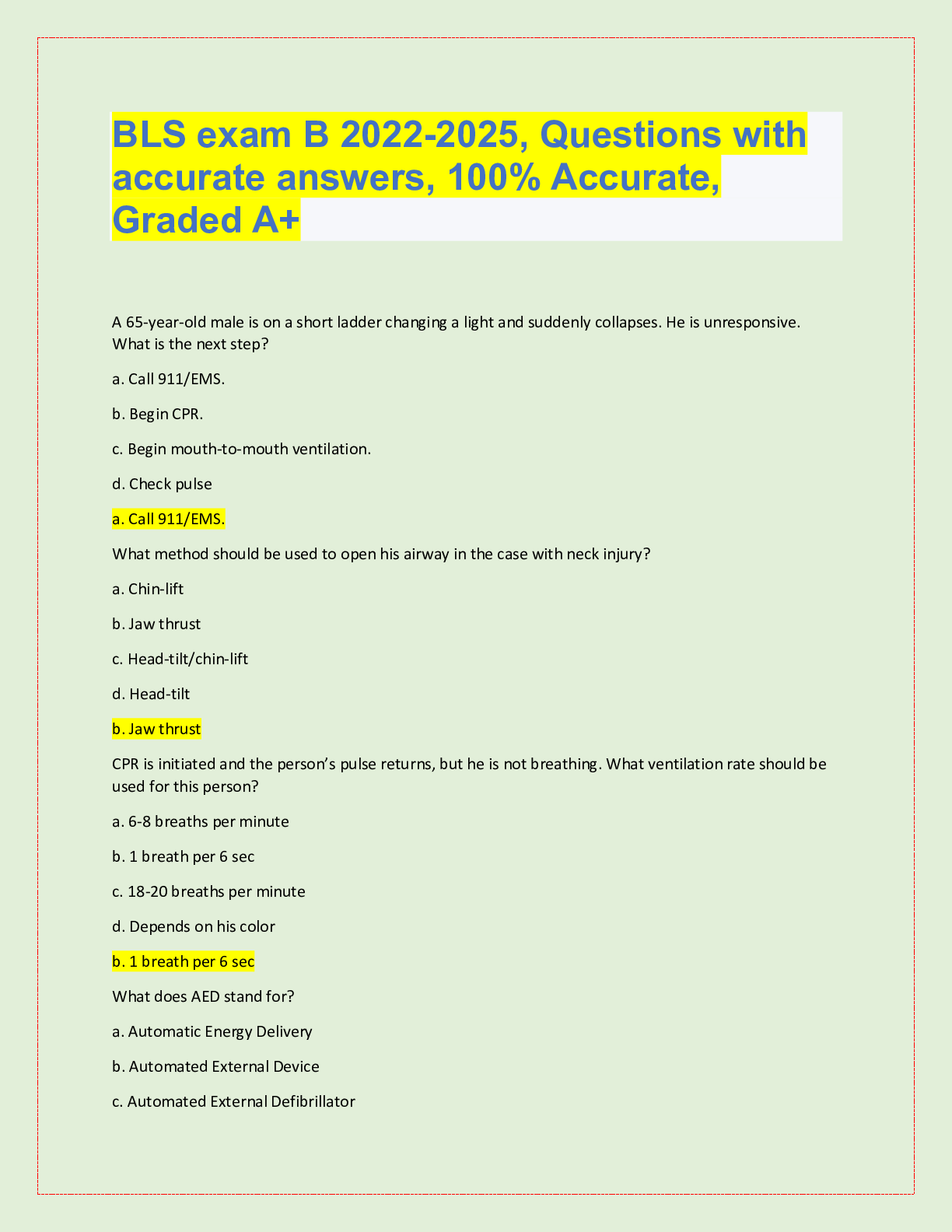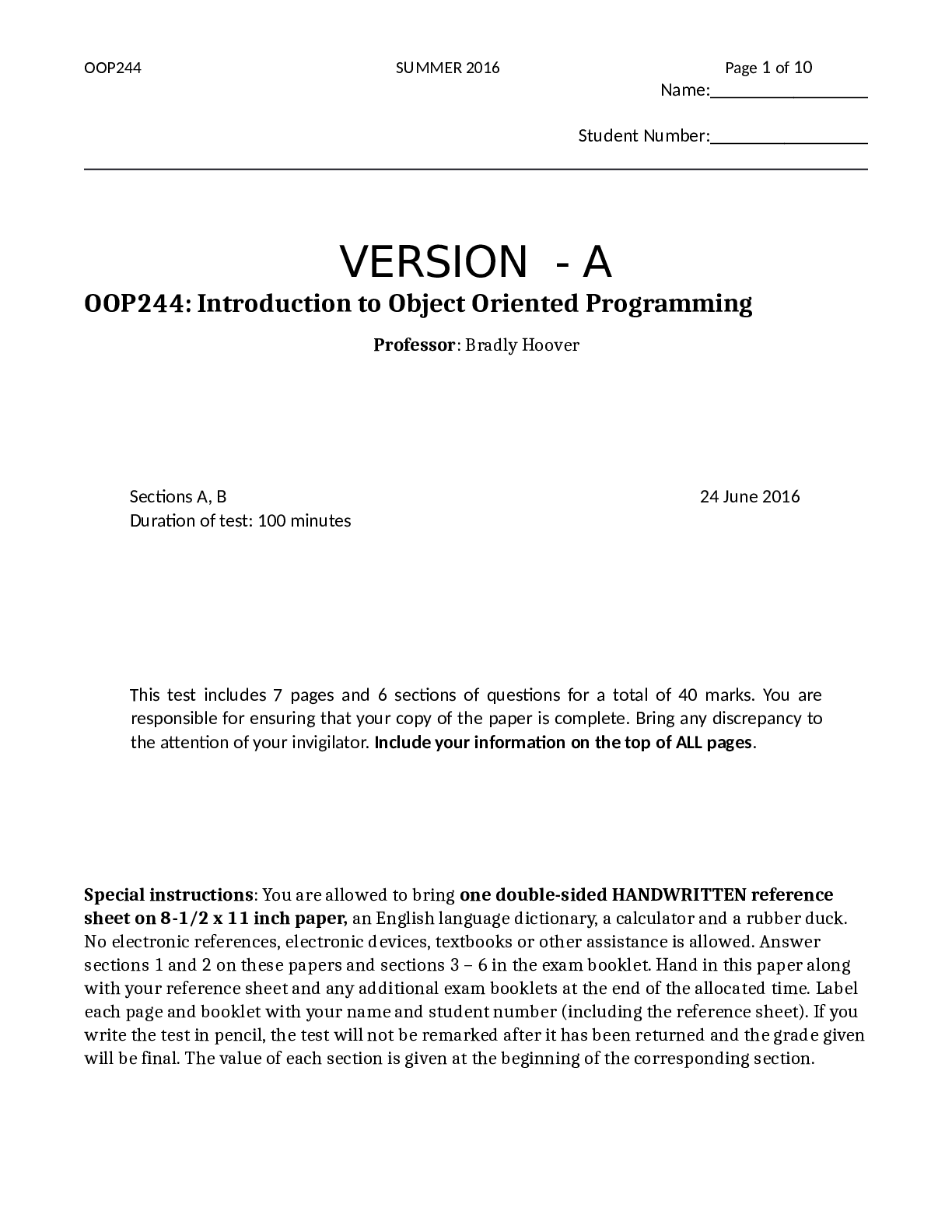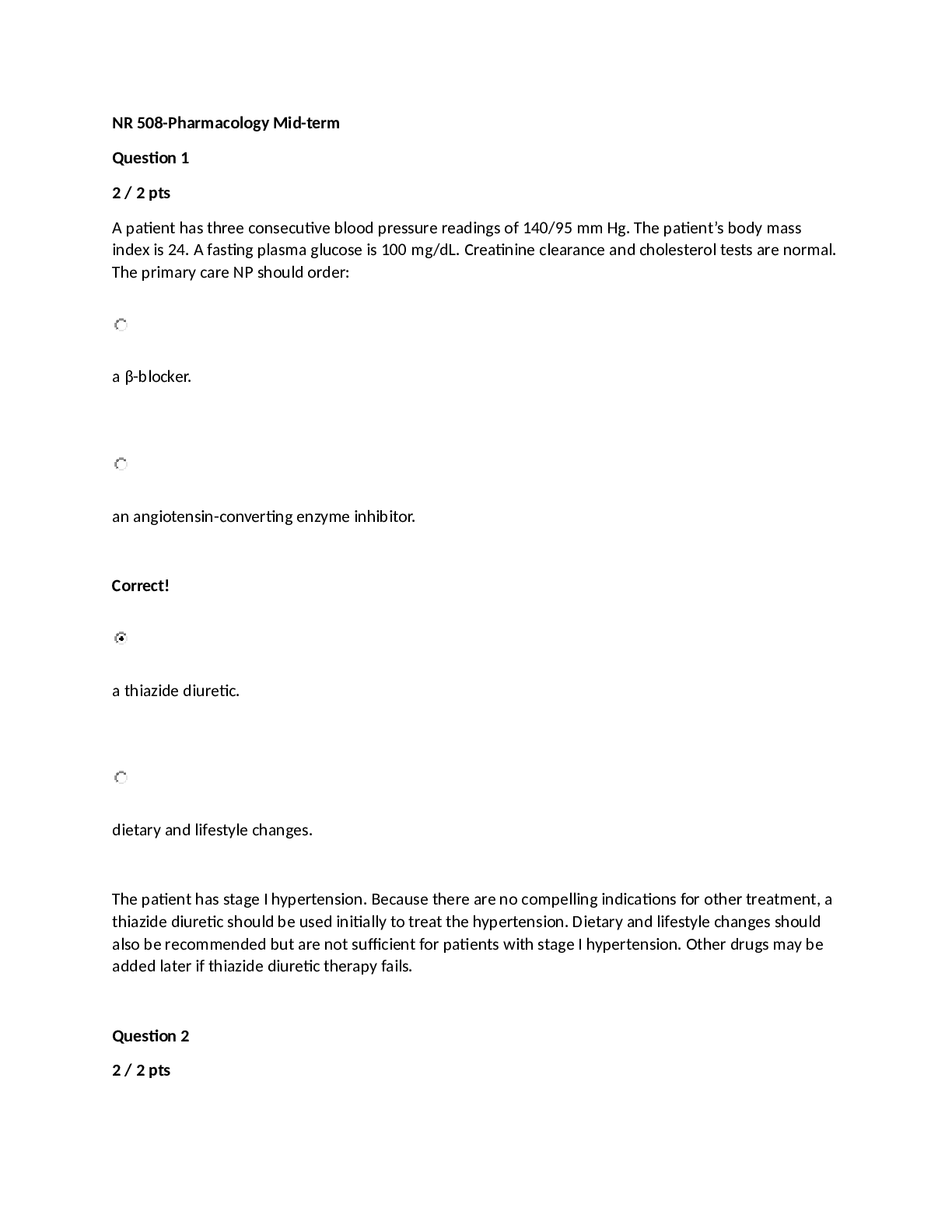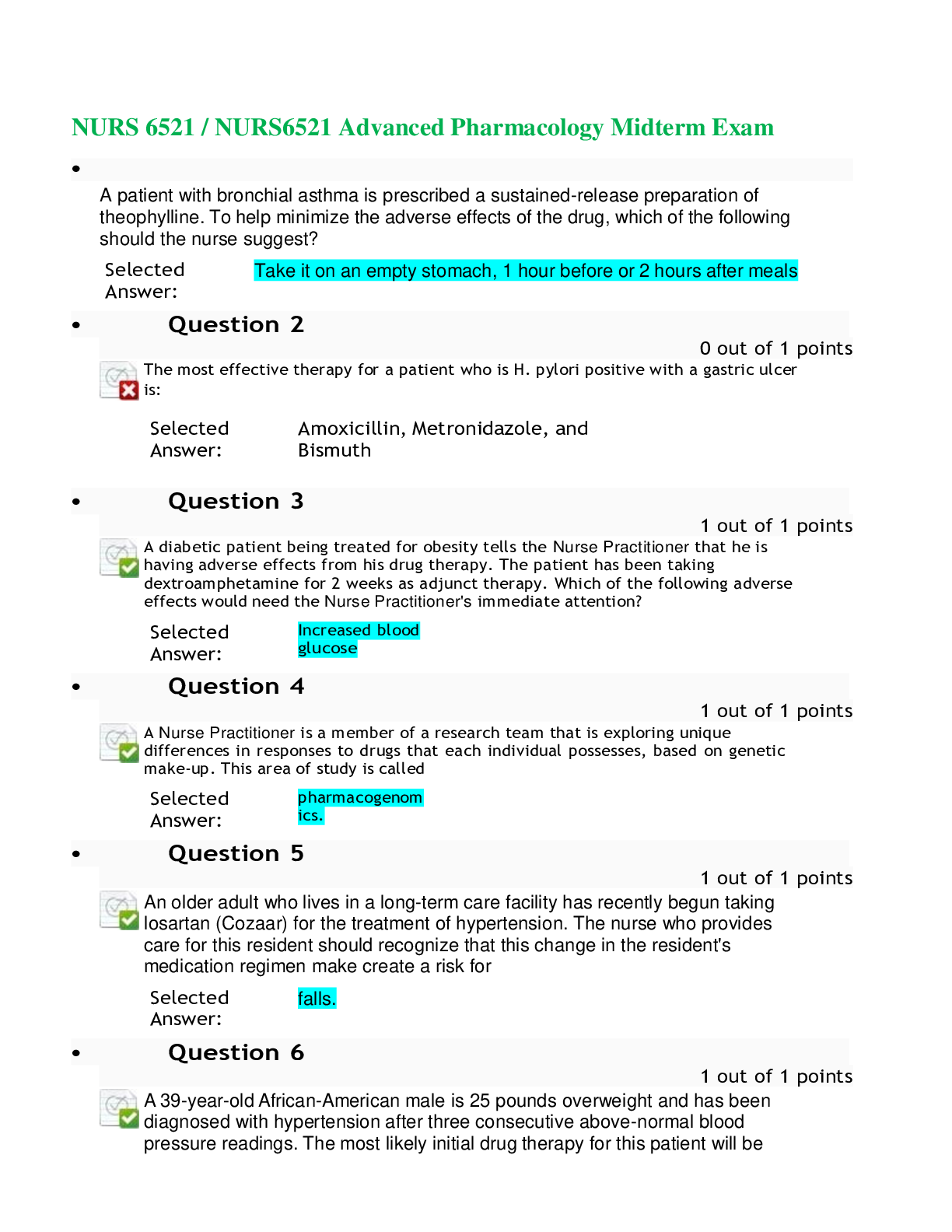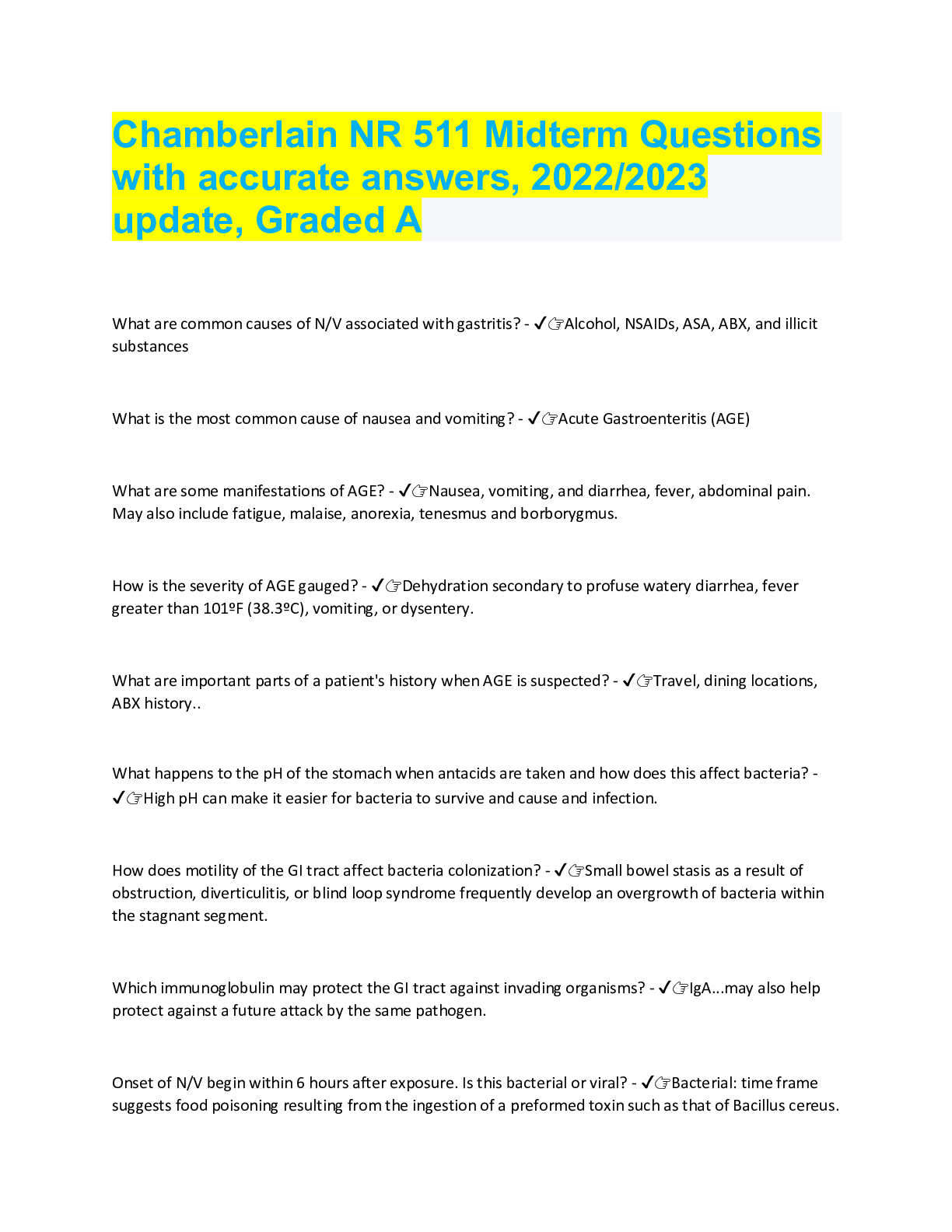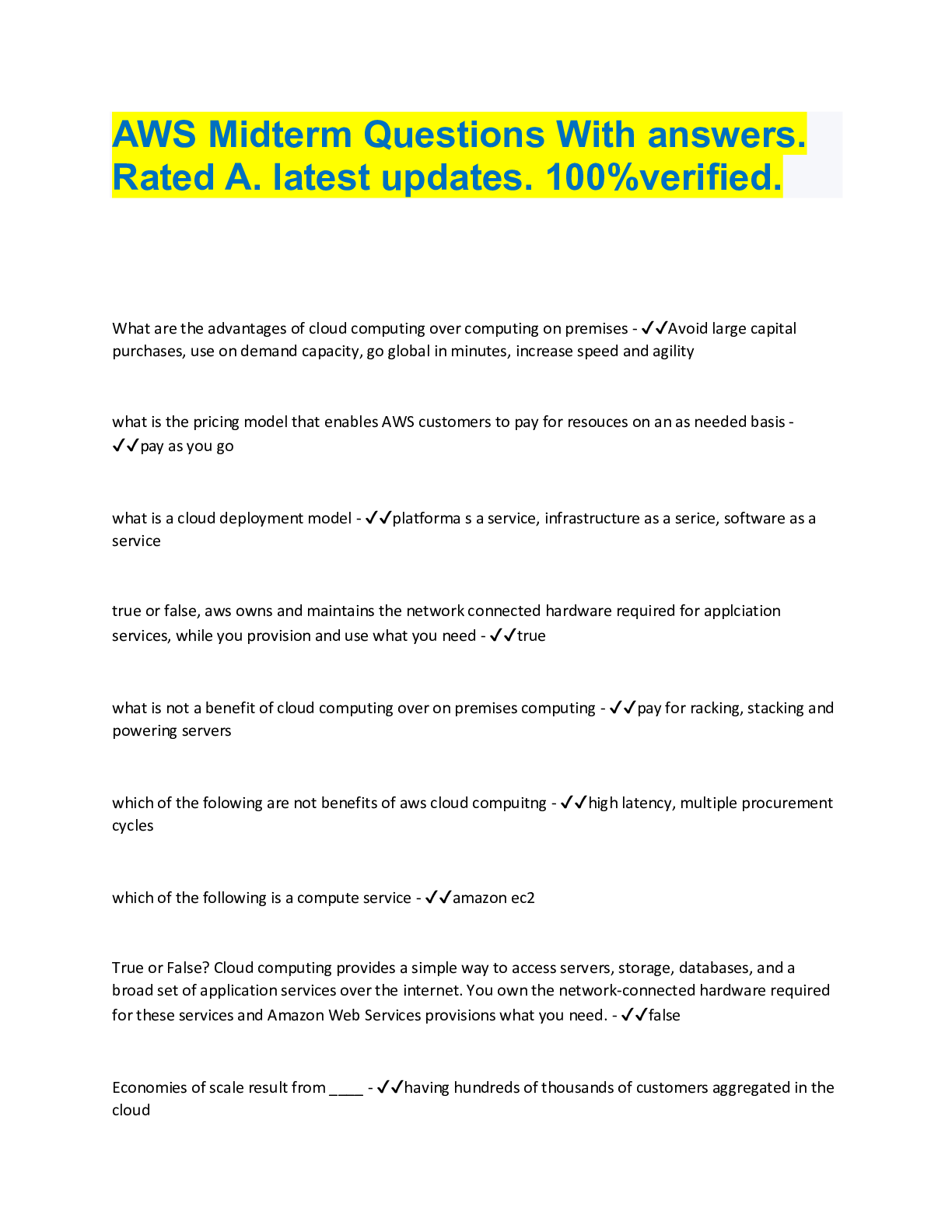*NURSING > QUESTIONS & ANSWERS > NR 511 Midterm Questions with accurate answers, Chamberlain University, Rated A (All)
NR 511 Midterm Questions with accurate answers, Chamberlain University, Rated A
Document Content and Description Below
NR 511 Midterm Questions with accurate answers, Chamberlain University, Rated A All of the following medications are used for the control of nausea and vomiting. Which medication works by affecting... the chemoreceptor trigger zone, thereby stimulating upper gastrointestinal motility and increasing lower esophageal sphincter pressure? 1.Anticholinergics, such as scopolamine (Donnatal). 2.Antidopaminergic agents, such as prochlorperazine (Compazine). 3.Antidopaminergic and cholinergic agents, such as metoclopramide (Reglan). 4.Tetrahydrocannabinols, such as dronabinol (Marinol) - ✔?Antidopaminergic and cholinergic agents, such as metoclopramide (Reglan) rationale: Metoclopramide (Reglan) is used for diabetic gastroparesis and postoperative nausea and vomiting. It works by affecting the chemoreceptor trigger zone, thereby stimulating upper gastrointestinal motility and increasing lower esophageal sphincter pressure You auscultate Julie's abdomen and hear a peritoneal friction rub. Which condition do you rule out? 1.Peritonitis. 2.A liver or spleen abscess. 3.A liver or spleen metastatic tumor. 4.Irritable bowel syndrome. - ✔?IBS rationale: IBS does not produce a friction rub You are counseling Lillian, who is lactose intolerant, about foods to avoid. You know she misunderstands the teaching when she tells you she can have: 1. Yogurt. 2.Foods containing whey. 3.Prehydrolyzed milk. 4.Oranges. - ✔?Foods containing whey rationale: Advise clients who are lactose intolerant to avoid foods containing whey. Whey is a lactose-rich ingredient found in some foods, so clients who are lactose intolerant need to read labels on all foods. To control symptoms, dietary lactose should be reduced or restricted by using lactose-reduced and lactose-free dairy products or by eating lactose-rich foods in small amounts or in combination with low-lactose or lactose-free foods. Simon, age 72, states that he is worried because he has a bowel movement only every third day. You respond: 1."You should have two to three stools per day." 2."You should defecate once a day." 3."You should have at least three stools per week." 4."There is no such thing as a 'normal' pattern of defecation." - ✔?There is no such thing as a normal pattern of defecation rationale: There is no such thing as a "normal" pattern of defecation. Patterns of defecation vary widely and may in part be affected by dietary habits, fluid intake, bacteria in the stool, psychological stress, or voluntary postponement of defecation. Defecating every third day could be the routine pattern for Simon. He should be questioned if this is routine for him. Timothy, age 68, complains of an abrupt change in his defecation pattern. You evaluate him for: 1.Constipation. 2.Colorectal cancer. 3.Irritable bowel syndrome. 4.Acute appendicitis. - ✔?Colorectal cancer rationale: A middle-aged or older client with an abrupt change in defecation pattern must be evaluated for colorectal cancer Ruby has a colostomy and complains that her stools are too loose. What food(s) do you suggest to help thicken the stools? 1.Cheese. 2.Leafy green vegetables. 3.Raw fruits and vegetables. 4.Dried beans. - ✔?Cheese rationale: Cheese, bread, pasta, rice, pretzels, and yogurt all help to thicken stools. Tina has a chronic hepatitis C infection. She asks you how to prevent its transmission. You respond: 1."Do not donate blood until one year after diagnosis." 2."Abstain from sex altogether." 3."There is no possibility of transmission through razors or toothbrushes." 4."Abstain from sex during your period." - ✔?Abstain from sex during your period rationale: Because the hepatitis C virus is transmitted in blood, including menstrual blood, clients should abstain from sex during menstruation. You might also test Tina to see which genotype her hepatitis C is to see if she is a candidate for Harvoni or Epclusa. Your client's 2-month-old daughter is admitted with gastroenteritis and dehydration after 2 days of vomiting and diarrhea. When the father asks you what is causing the child's diarrhea, how do you respond? 1."She must be lactose intolerant from the formula, and this is altering the fluid balance." 2."Her body's telling you that it's time to introduce some solids into her system." 3."The virus is causing irritation of the gastrointestinal lining, which causes diarrhea." 4."The infectious agent invaded the stomach lining and is affecting the balance of water and nutrients." - ✔?"The infectious agent invaded the stomach lining and is affecting the balance of water and nutrients." rationale: In 80% of cases, gastroenteritis is viral in nature. This viral infection causes diarrhea by stimulating the secretion of electrolytes into the intestine. This is rapidly followed by water along the osmotic gradient, resulting in watery stools. Sandy, age 52, presents with jaundice, dark urine, and light-colored stools, stating that she is slightly improved over last week's symptoms. Which stage of viral hepatitis do you suspect? 1.Incubation. 2.Prodromal. 3.Icteric. 4.Convalescent. - ✔?Icteric rationale: In the icteric stage of viral hepatitis, there is jaundice, dark urine, and light-colored stools. There are continued prodromal complaints, with gradual improvement. Rose, a client with gastroesophageal reflux disease (GERD), has many other concurrent conditions. In teaching Rose about medications to avoid, what do you recommend she refrain from using? 1.Antibiotics. 2.Nonsteroidal anti-inflammatory drugs (NSAIDs). 3.Oral contraceptives. 4.Antifungals. - ✔?NSAIDS rationale: Clients with GERD should avoid taking NSAIDs because they tend to aggravate the already irritated gastric mucosa. Lucy, age 49, has pain in both the left and right lower quadrants. What might you suspect? 1.A gastric ulcer. 2.Gastritis. 3.Pelvic inflammatory disease. 4.Pancreatitis. - ✔?PID rationale: The pain associated with pelvic inflammatory disease can be palpated in both the right and left lower quadrants. In a 2-month-old infant with vomiting and diarrhea, the most effective way of determining a fluid deficit is to check for: 1.Decreased peripheral perfusion. 2.Hyperventilation. 3.Irritability. 4. Hyperthermia. - ✔?Decreased peripheral perfusion rationale: In a 2-month-old infant with vomiting and diarrhea, the most effective way of determining a fluid deficit is to check for decreased peripheral perfusion, dry oral mucous membranes, and sunken fontanels. The body compensates for loss of fluid by shifting the interstitial fluid into the intravascular space, thereby maintaining perfusion of vital organs. If the fluid loss continues, circulating volume is diminished and vasoconstriction occurs in the peripheral vessels, resulting in decreased perfusion You suspect that Harry has a peptic ulcer and tell him that it has been found to be strongly associated with: 1.Anxiety and panic attacks. 2.Long-term use of nonsteroidal anti-inflammatory drugs (NSAIDs). 3.Infection by Helicobacter pylori. 4.A family history of peptic ulcers. - ✔?Infection by H. Pylori rationale: About 90% of cases of peptic ulcers have been found to be caused by infection with the bacteria H pylori You suspect that Nikki has a gastroduodenal ulcer caused by Helicobacter pylori and plan to treat her empirically. What medications should you order? 1.A proton pump inhibitor (omeprazole), tetracycline or amoxicillin, and metronidazole (Flagyl). 2.Bismuth subsalicylate (Pepto-Bismol) and omeprazole (Prilosec). 3.Amoxicillin (Amoxil) and omeprazole (Prilosec). 4.Clarithromycin (Biaxin) and metronidazole (Flagyl) - ✔?Amoxicillin (Amoxil) and omeprazole (Prilosec) rationale: Both drugs listed are used in the eradication of H pylori, but do not complete the regimen. A 7-year-old male presents with his mother to the urgent care clinic complaining of abdominal pain. He started to complain of pain prior to going to bed; however, it has gotten progressively worse and is now preventing him from sleeping. He is nauseous but hasn't vomited and didn't eat dinner due to the pain. The patient appears pale and is complaining of right-sided abdominal pain. His vitals are as follows: blood pressure 130/85, pulse 120, temperature 100.5°F, pulse oximetry 98% on room air. On physical exam he is tender in the right lower quadrant. His complete blood count (CBC) shows a white blood cell count (WBC) of 17.0. What is the patient's likely diagnosis? 1.Appendicitis. 2.Cholecystitis. 3.Constipation. 4.Gastroenteritis - ✔?appendicitis rationale: This is the clinical scenario typical for appendicitis What is the recommended treatment to eradicate a Helicobacter pylori infection? 1.Ranitidine, amoxicillin, and clarithromycin for 2 weeks. 2.Amoxicillin, clarithromycin, and omeprazole for 2 weeks. 3.Bismuth, amoxicillin, and clarithromycin for 2 weeks. 4.Bismuth, doxycycline, metronidazole, and ranitidine. - ✔?Amoxicillin, clarithromycin, and omeprazole for 2 weeks rationale: This is the recommended treatment to eradicate H pylori. A 50-year-old female presents to the urgent care clinic complaining of left lower quadrant pain. She has associated nausea and vomiting, and her vital signs are as follows: temperature 102.5°F, pulse 110, blood pressure 150/90, pulse oximetry 99% on room air. What is the best test to evaluate this patient? 1.Sigmoidoscopy. 2.Abdominal series. 3.Computed tomography (CT) scan with oral contrast. 4.Abdominal ultrasound. - ✔?Computed tomography (CT) scan with oral contrast rationale: This is the best diagnostic choice. While diverticulitis is likely the cause of the patient's symptoms, a CT of the abdomen would show if the patient has any gynecologic etiology (such as ovarian cyst or tumor) of this pain Which gastrointestinal disease below could theoretically be completely eradicated with a total colectomy? 1.Crohn's disease. 2.Irritable bowel syndrome. 3.Ulcerative colitis. 4.Celiac disease - ✔?Ulcerative Colitis rationale: Ulcerative colitis is a disease only of the colon. While it is not the first treatment choice, total colectomy is a treatment option that can completely resolve this problem The screening guidelines for colon cancer recommend which of the following for the general population? 1.Colonoscopy starting at age 50. 2.Colonoscopy starting at age 45. 3.Fecal occult blood test (FOBT) and rectal exam starting at age 50. 4.Fecal occult blood test (FOBT) and rectal exam starting at age 45. - ✔?Colonoscopy after age 50 rationale: This is the recommended age to start colonoscopic examination in someone with a low risk for colon cancer Which of the following is not a risk factor for cholecystitis? 1.Female gender. 2.Obesity. 3.Sickle cell anemia. 4.Younger age - ✔?Younger age rationale: The risk of cholecystitis actually increases with age A 54-year-old female presents to your primary care office for routine reevaluation for gastroesophageal reflux disease (GERD). She has been treated with diet modifications and 6 weeks of omeprazole without improvement of her symptoms. What is the next step in management of this patient's GERD? 1.Order an endoscopy. 2.Order a Helicobacter pylori blood test. 3.Try adding ranitidine to the patient's regimen. 4.Try adding bismuth to the patient's regimen. - ✔?Order an endoscopy rationale: This is the next step in treatment in order to evaluate the etiology of the patient's GERD and consider biopsy if necessary A 25-year-old male presents with "bleeding in my eye" for 1 day. He awoke this morning with a dark area of redness in his eye. He has no visual loss or changes. He denies constitutional symptoms, pruritus, drainage, or recent trauma. The redness presents on physical exam as a dark red area in the patient's sclera of the right eye only and takes up less than 50% of the eye. The patient's remaining sclera is clear and white. He also notes he was drinking alcohol last night and vomited afterward. What is the best treatment? 1.Topical steroids and close follow-up with an ophthalmologist. 2.Sending the patient to the emergency department for immediate ophthalmology consult. 3.Reassurance that this lesion will resolve without any treatment in 2 to 4 weeks. 4.Cold compresses and frequent handwashing - ✔?Reassurance that this lesion will resolve without any treatment in 2 to 4 weeks. rationale: This is the classic presentation of a subconjunctival hemorrhage. It will resolve without treatment in 2 to 4 weeks. Vomiting probably caused his hemorrhage Which of the following statements about macular degeneration is not true? 1.Macular degeneration is characterized by gradual loss of peripheral vision. 2.Macular degeneration is the leading cause of blindness in people younger than 60. 3.Tobacco use is a risk factor for macular degeneration. 4.There are 2 different types of macular degeneration: wet and dry - ✔?Macular degeneration is characterized by gradual loss of peripheral vision rationale: This is how open-angle glaucoma is characterized. Macular degeneration is gradual loss of central vision A 75-year-old female presents to your office complaining of dizziness and hearing loss. The patient states she awoke yesterday with dizziness, which she described as feeling the room spinning. She also notes intermittent ringing in her ears. On physical exam, the patient has lateralization of her hearing loss to the unaffected ear. Rinne test shows air conduction lasts longer than bone conduction. What is the next step in helping this patient's symptoms? 1.Order a computed tomography (CT) scan to rule out acoustic neuroma. 2.Start her on high-dose Augmentin. 3.Start the patient on a low-salt, low-caffeine diet and give her meclizine for vertigo attacks. 4.Immediate referral to an ear, nose, and throat (ENT) specialist - ✔?Start the patient on a low-salt, low-caffeine diet and give her meclizine for vertigo attacks rationale: This is the treatment for symptoms of Meniere disease. You would also want to consider an ear, nose, and throat consult to rule out other etiologies of the patient's symptoms. Meniere disease is diagnosed based on history and the exclusion of other conditions as well What is the most common bacterial pathogen associated with acute otitis media? 1.Streptococcus pneumoniae. 2.Haemophilus influenzae. 3.Streptococcus pyogenes. 4.Moraxella (Branhamella) catarrhalis. - ✔?Streptococcus pneumoniae rationale: This causes 40% to 50% of cases. A 20-year-old male presents to your primary care clinic. This patient is a college student. He complains of fatigue, sore throat, and low-grade fever for 3 days. On physical exam, he has a temperature of 100.7°F. His ear exam is normal. His nose and throat exam shows mild erythema of the nasal mucosa and edematous, enlarged tonsils bilaterally, with erythema of the pharyngeal wall and tonsillar exudates. He has inflamed posterior cervical lymph nodes. He has a mild nonproductive cough and clear lung exam. What is his most likely diagnosis? 1.Viral pharyngitis. 2.Mononucleosis. 3.Streptococcal pharyngitis. 4.Upper respiratory infection - ✔?Mono rationale: This presentation could be a viral pharyngitis; however, with posterior cervical lymphadenitis, you would suspect mononucleosis. The antibiotic of choice for recurrent acute otitis media (AOM) and/or treatment failure in children is: 1.Amoxicillin (Amoxil). 2.Amoxicillin and potassium clavulanate (Augmentin). 3.Azithromycin (Zithromax). 4.Prednisone (Deltasone) - ✔?Augmentin rationale: The antibiotic of choice for recurrent AOM or treatment failure is amoxicillin and potassium clavulanate (Augmentin) A 65-year-old man presents complaining of a left-sided, deep, throbbing headache and mild fatigue. On examination, the client has a tender, tortuous temporal artery. You suspect giant cell arteritis (GCA), or temporal arteritis. What is the least invasive procedure to help with diagnosis? 1. Magnetic resonance imaging (MRI) of the head. 2.Erythrocyte sedimentation rate (ESR). 3.Electroencephalogram (EEG). 4.Otoscopy - ✔?ESR rationale: An elevated ESR—anywhere from 30 to 100 mm/h—may be seen in giant cell arteritis (temporal arteritis); however, the ESR may also be normal. The temporal artery supplies the optic nerve; if temporal arteritis is suspected due to the age of the client (50 and older) and the location and character of the pain, it is essential that a referral to a surgeon be made for immediate biopsy of the artery before damage to the optic nerve occurs. A temporal artery biopsy (TAB), an invasive procedure, is the criterion standard for diagnosing temporal arteritis Aaron, age 4, is brought in to the clinic by his father. His tympanic membrane is perforated from otitis media. His father asks about repair of the eardrum. How do you respond? 1."The eardrum, in most cases, heals within several weeks." 2."We need to schedule Aaron for a surgical repair." 3."He must absolutely stay out of the water for 3 to 6 months." 4."If the eardrum is not healed in several months, it can be surgically repaired." - ✔?"The eardrum, in most cases, heals within several weeks. rationale: Most perforated tympanic membranes seen with acute otitis media heal within several weeks Martin, age 24, presents to the office with an erythematous ear canal and pain on manipulation of the auricle. He is on vacation and has been swimming daily at the resort. What is your diagnosis? 1.Acute otitis media. 2.Chronic otitis media. 3.External otitis. 4.Temporomandibular joint (TMJ) syndrome - ✔?External otitis rationale: With external otitis, there is pain, an erythematous ear canal, and usually a history of recent swimming Max, age 35, states that he thinks he has an ear infection because he just flew back from a business trip and feels unusual pressure in his ear. You diagnose barotrauma. What is your next action? 1.Prescribe nasal steroids and oral decongestants. 2.Prescribe antibiotic ear drops. 3.Prescribe systemic antibiotics. 4.Refer Max to an ear, nose, and throat specialist - ✔?Prescribe nasal steroids and oral decongestants. rationale: Barotrauma of the auditory canal, causing a sensation of abnormal middle ear pressure, may be relieved by the use of nasal steroids and oral decongestants. A 64-year-old obese woman comes in complaining of difficulty swallowing for the past 3 weeks. She states that "some foods get stuck" and she has been having "heartburn" at night when she lies down, especially if she has had a heavy meal. Occasionally, she awakes at night coughing. She denies weight gain and/or weight loss, vomiting, or change in bowel movements or color of stools. She denies alcohol and tobacco use. There is no pertinent family history or findings on review of systems (ROS). Physical examination is normal, with no abdominal tenderness, and the stool is occult blood (OB) negative. What is the most likely diagnosis? 1.Esophageal varices. 2.Esophageal cancer. 3.Gastroesophageal reflux disease (GERD). 4.Peptic ulcer disease (PUD) - ✔?Gastroesophageal reflux disease (GERD) rationale: Though the historical data are incomplete, this client has no obvious risk factors for esophageal varices or esophageal cancer. She is a nondrinker and denies weight loss and changes in bowel function or color of stools, which could be a clue to a gastrointestinal bleed. The fact that her worst symptoms occur at night with regurgitation and heartburn is classic for GERD. Dysphagia is frequently a prominent symptom of GERD. She has no abdominal tenderness, and aside from the nighttime symptoms and dysphagia, she reports no symptoms with food or lack of food Mr. Clark, age 78, is being treated with timolol maleate (Timoptic) drops for his chronic open-angle glaucoma. While performing a new client history and physical, you note that he is taking other medications. Which medication would you be most concerned about? 1.Aspirin therapy as prophylaxis for heart attack. 2.Ranitidine (Zantac) for gastroesophageal reflux disease. 3.Alprazolam (Xanax), an anxiolytic. 4.Atenolol (Tenormin), a beta blocker for high blood pressure - ✔?Atenolol (Tenormin), a beta blocker for high blood pressure rationale: If a client is taking timolol maleate (Timoptic) drops for chronic open-angle glaucoma, you should be most concerned if the client is also taking atenolol (Tenormin), a beta blocker, for high blood pressure. Because timolol maleate drops are beta-adrenergic blockers, additional beta blockers can cause worsening of congestive heart failure or reactive airway disease, as well as acute delirium. Mario, a 17-year-old high school student, came to the office for evaluation. He is complaining of persistent sore throat, fever, and malaise not relieved by the penicillin therapy prescribed recently at the urgent care center. As the nurse practitioner, what would you order next? 1.A throat culture. 2.A Monospot test. 3.A rapid antigen test. 4. Thayer-Martin plate test. - ✔?A Monospot test rationale: If a client has a persistent sore throat, fever, and malaise not relieved by penicillin therapy, a Monospot test should be performed to rule out mononucleosis (Epstein-Barr virus) Cynthia, a 31-year-old woman with a history of depression, is seen in the office today for complaints of headaches. She was recently promoted at her job, and this has caused increased stress. She describes the headache as a tightening (viselike) feeling in the temporal and nuchal areas. The pain is bilateral and tends to wax and wane. It started approximately 2 days ago and is still present. What kind of headache is she describing? 1.Classic migraine. 2.Tension headache. 3.Sinus headache. 4.Cluster headache - ✔?Tension headache rationale: Tension headache is the most common type of headache. These headaches are usually bilateral and tend to wax and wane but have a characteristic pressure/tightening (viselike grip) in the forehead, temporal, or nuchal areas and can last from minutes to weeks. Tension headache may be associated with stress, depression, or anxiety disorders Regular ocular pressure testing is indicated for older adults taking: 1.High-dose inhaled glucocorticoids. 2.Nonsteroidal anti-inflammatory drugs (NSAIDs). 3.Angiotensin-converting enzyme (ACE) inhibitors. 4.Insulin - ✔?High-dose inhaled glucocorticoids. rationale: Although regular ocular pressure testing is indicated on a routine basis for all older adults, it is especially important for clients taking an extended regimen of high-dose inhaled glucocorticoids because prolonged continuous use increases the risk of ocular hypertension or open-angle glaucoma. In a young child, unilateral purulent rhinitis is most often caused by: 1.A foreign body. 2.A viral infection. 3.A bacterial infection. 4.An allergic reaction - ✔?FB rationale: In a young child, unilateral purulent rhinitis is most often caused by a foreign body. The key word here is unilateral Samantha, age 12, presents with ear pain. When you begin to assess her ear, you tug on her normal-appearing auricle, eliciting severe pain. This leads you to suspect: 1.Otitis media. 2.Otitis media with effusion. 3.Otitis externa. 4.Primary otalgia. - ✔?otitis externa rationale: When severe pain is elicited by tugging on a normal-appearing auricle, an acute infection of the external ear canal (otitis externa) is suspected Kathleen, age 54, has persistent pruritus of the external auditory canal. External otitis and dermatological conditions, such as seborrheic dermatitis and psoriasis, have been ruled out. What can you advise her to do? 1.Use a cotton-tipped applicator daily to remove all moisture and potential bacteria. 2.Wash daily with soap and water. 3.Apply mineral oil to counteract dryness. 4.Avoid topical corticosteroids. - ✔?Apply mineral oil to counteract dryness. rationale: Pruritus of the external ear canal is a common problem. In most cases, the pruritus is self-induced from overenthusiastic cleaning or excoriation. The protective cerumen covering must be allowed to regenerate and may be helped to do so by application of a small amount of mineral oil, which helps counteract dryness and reject moisture. Often, the use of isopropyl alcohol may relieve ear canal pruritus as well At the clinic, you are assessing Kyle, a 4-month-old baby, for the first time and notice that both eyes are turning inward. What is this called? 1.Pseudostrabismus. 2.Strabismus. 3.Esotropia. 4.Exotropia - ✔?Esotropia rationale: Esotropia is the inward turning of the eyes Kevin, age 26, has AIDS and presents to the clinic with complaints of a painful tongue covered with what look like creamy white, curdlike patches overlying erythematous mucosa. You are able to scrape off these "curds" with a tongue depressor, which assists you in making which of the following diagnoses? 1.Leukoplakia. 2.Lichen planus. 3.Oral candidiasis. 4.Oral cancer. - ✔?Oral candidiasis rationale: Oral candidiasis (thrush) is distinctive because the white areas on the tongue can be rubbed off with a tongue depressor. Thrush may be seen in denture wearers, in debilitated clients, and in those who are immunocompromised or taking corticosteroids or broad-spectrum antibiotics What is the most common cause of epistaxis? 1.Digital trauma. 2.Warfarin. 3.Vitamin C deficiency. 4.Hemophilia A - ✔?digital trauma rationale: Picking the nose is the most common cause of nosebleeds You are the nurse practitioner caring for Martha, a 47-year-old accountant. You have made a diagnosis of acute sinusitis based on Martha's history and the fact that she complains of pain behind her eye. Which sinuses are affected? 1.Maxillary. 2.Ethmoid. 3.Frontal. 4.Sphenoid - ✔?ethmoid rationale: With ethmoid sinus problems, the pain is felt behind the eye and high on the nose A 25-year-old client who plays in a band complains that he finds it difficult to understand his fellow musicians at the end of a night of performing, a problem that is compounded by the noisy environment of the club. These symptoms are most characteristic of which of the following? 1.Sensorineural loss. 2.Conductive loss. 3.Tinnitus. 4.Vertigo. - ✔?sensorineural hearing loss rationale: Sensorineural loss comes from exposure to loud noises, inner ear infections, tumors, congenital and familial disorders, and aging. The results of the Weber and Rinne tests will assist in the diagnosis Mandy, 44, was given a diagnosis of flu 1 day ago and wants to start on the "new flu medicine" right away. What do you tell her? 1."The medication is effective only if started within the first 72 hours after symptoms begin." 2."If you treat a cold, it goes away in 7 days; if you don't treat it, it goes away in 1 week." 3."The medicine has not proven its effectiveness." 4. "I'll start you on oseltamivir (Tamiflu) today. It may shorten the course of the disease and perhaps lessen the severity of your symptoms." - ✔?"I'll start you on oseltamivir (Tamiflu) today. It may shorten the course of the disease and perhaps lessen the severity of your symptoms. rationale: Two antiviral drugs, oseltamivir (Tamiflu), a pill taken by mouth, and zanamivir (Relenza), an inhaled medication, are particularly effective against the influenza viruses that cause the flu. If the virus causing the flu is type A influenza, the client may benefit from either one of these drugs Marjorie, age 37, has asthma and has been told she has nasal polyps. What do you tell her about them? 1.Nasal polyps are usually precancerous. 2.Nasal polyps are benign growths. 3.The majority of nasal polyps are neoplastic. 4.They are probably inflamed turbinates, not polyps, because polyps are infrequent in clients with asthma. - ✔?Nasal polyps are benign growths rationale: Nasal polyps are benign growths that occur frequently in clients with sinus problems, asthma, and allergic rhinitis. Polyps are neither neoplastic growths nor precancerous, but they do have the potential to affect the flow of air through the nasal passages. Clients who have asthma and have nasal polyps may have an associated allergy to aspirin, a syndrome that is referred to as Samter triad Nystatin (Mycostatin) is ordered for Michael, a 56-year-old banker who has an oral fungal infection. What instructions for taking the medication do you give Michael? 1."Dilute the oral medication with one tablespoon of water for easier digestion." 2."Take the medication with meals so that it's absorbed better." 3."Swish and swallow the medication." 4."Apply the medication only to the lesions. - ✔?"Swish and swallow the medication." rationale: When ordering nystatin (Mycostatin) for an oral fungal infection, tell the client to swish the medication in the mouth to coat all the lesions and then to swallow it. Erica, age 39, has a sudden onset of shivering, sweating, headache, aching in the orbits, and general malaise and misery. Her temperature is 102°F. The nurse practitioner diagnosed her with influenza (flu). What is your next course of action? 1.Order amoxicillin (Amoxil) 500 mg every 12 hours for 7 days. 2.Prescribe rest, fluids, acetaminophen (Tylenol), and possibly a decongestant and an antitussive. 3.Order a complete blood count (CBC). 4.Consult with your collaborating physician - ✔?Prescribe rest, fluids, acetaminophen (Tylenol), and possibly a decongestant and an antitussive. rationale: Management of flu is generally symptomatic and includes rest, fluids, acetaminophen (Tylenol), and possibly a decongestant and an antitussive. The client should be advised to call or return to the clinic in 4 days if symptoms are not improving [Show More]
Last updated: 2 years ago
Preview 1 out of 66 pages
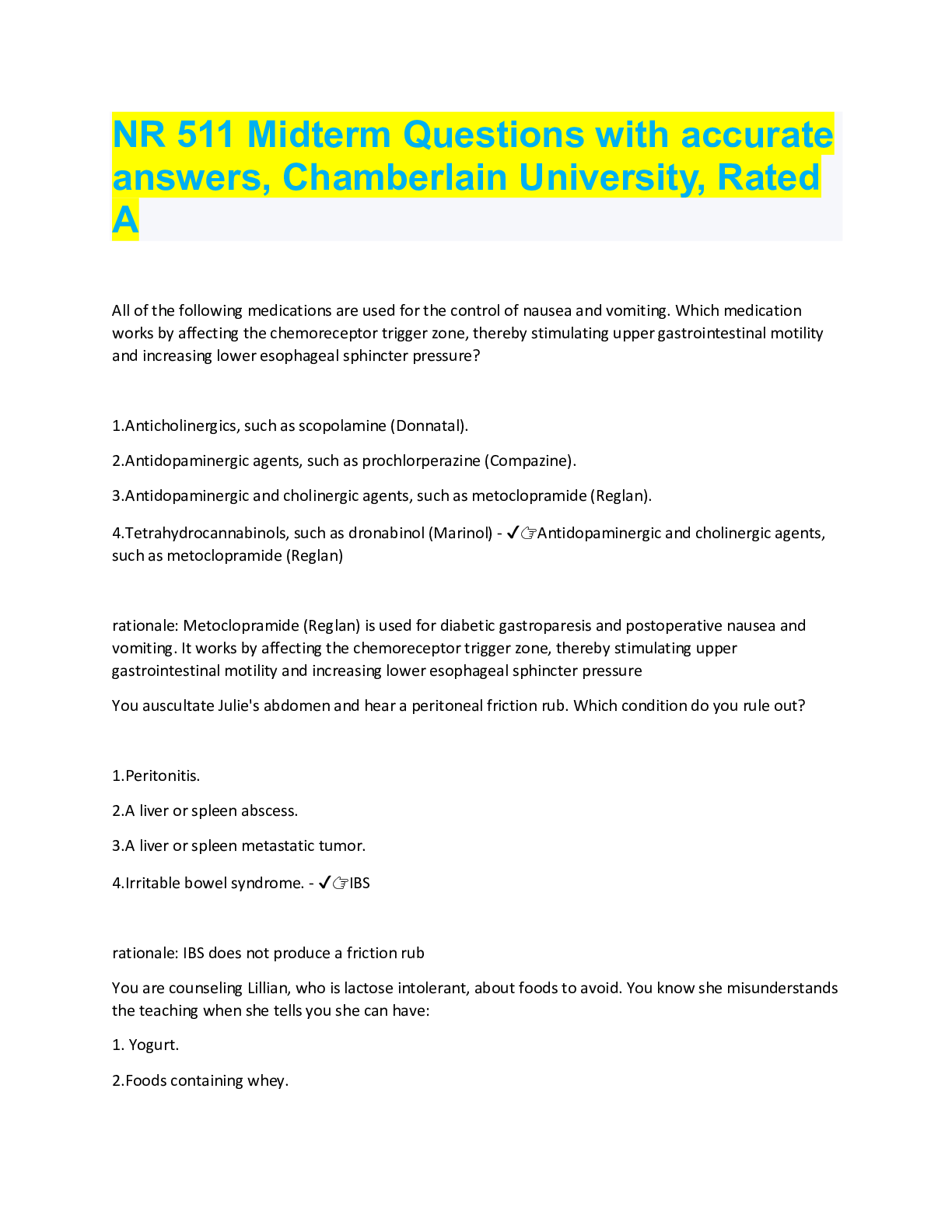
Buy this document to get the full access instantly
Instant Download Access after purchase
Buy NowInstant download
We Accept:

Reviews( 0 )
$12.00
Can't find what you want? Try our AI powered Search
Document information
Connected school, study & course
About the document
Uploaded On
Sep 24, 2022
Number of pages
66
Written in
Additional information
This document has been written for:
Uploaded
Sep 24, 2022
Downloads
0
Views
145


